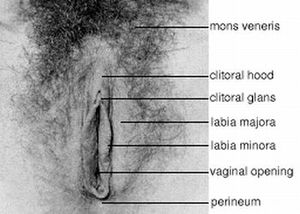Vulva
The vulva (from Latin, vulva, plural vulvae or vulvas; see etymology) is the region of the external genital organs of the female, including the labia majora, mons pubis, labia minora, clitoris, bulb of the vestibule, vestibule of the vagina, greater and lesser vestibular glands, and vaginal orifice.
The vulva has many major and minor anatomical structures. Its development occurs during several phases, chiefly the fetal and pubertal periods. Outer portal of the human matrix or womb, it protects its opening by a "double door": the labia majora and the labia minora, as well as a vulval vestibule, and a normal microbial flora that flows from the inside out. Normal external cleanliness is usually sufficient to assure good vulvovaginal health, without recourse to any internal cleansing. The vulva is more susceptible to infections than the penis.
These external body structures also have a sexual function; they are richly innervated and provide pleasure when properly stimulated. Since the origin of human society, in various branches of art the vulva has been depicted as the organ that has the power both "to give life" (i.e., often associated with the womb in pre-historic periods and antiquity, decreasingly so as science has progressed), and to give sexual pleasure to humankind.
In common speech, the term vagina is often used to refer to the vulva or female genitals generally, although, strictly speaking, the vagina is a specific internal structure, whereas the vulva is the exterior genitalia.
This article deals with the human vulva, although the structures are similar for other mammals.
- More information is available at [ Wikipedia:Vulva ]
Chat rooms • What links here • Copyright info • Contact information • Category:Root
